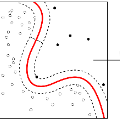Unsupervised visual anomaly detection conveys practical significance in many scenarios and is a challenging task due to the unbounded definition of anomalies. Moreover, most previous methods are application-specific, and establishing a unified model for anomalies across application scenarios remains unsolved. This paper proposes a novel hybrid framework termed Siamese Transition Masked Autoencoders(ST-MAE) to handle various visual anomaly detection tasks uniformly via deep feature transition. Concretely, the proposed method first extracts hierarchical semantics features from a pre-trained deep convolutional neural network and then develops a feature decoupling strategy to split the deep features into two disjoint feature patch subsets. Leveraging the decoupled features, the ST-MAE is developed with the Siamese encoders that operate on each subset of feature patches and perform the latent representations transition of two subsets, along with a lightweight decoder that reconstructs the original feature from the transitioned latent representation. Finally, the anomalous attributes can be detected using the semantic deep feature residual. Our deep feature transition scheme yields a nontrivial and semantic self-supervisory task to extract prototypical normal patterns, which allows for learning uniform models that generalize well for different visual anomaly detection tasks. The extensive experiments conducted demonstrate that the proposed ST-MAE method can advance state-of-the-art performance on multiple benchmarks across application scenarios with a superior inference efficiency, which exhibits great potential to be the uniform model for unsupervised visual anomaly detection.
翻译:未经监督的视觉异常检测在许多情景中都具有实际意义,并且是一项具有挑战性的任务,因为异常现象的定义没有限制。此外,大多数先前的方法都是应用专用的,而建立不同应用情景之间异常现象的统一模型仍未解决。本文件提议了一个新型混合框架,称为Siamsese Transport Masked Autoencarders(ST-MAE),通过深度特征过渡,统一处理各种视觉异常检测任务。具体地说,拟议方法首先从一个事先经过训练的深层脉冲神经网络中提取等级语义特征,然后开发一个特征脱钩战略,将深层特征分为两个脱钩功能补补分组。利用分解功能的特性,开发出一个统一的模型,与Siaeseeneeneeneene的编码师一起开发ST-MAE,在每组特征的每组中运行一个组合,并进行两个子片段的潜在表达式表达。轻度解码解码解码解码器,从过渡的潜值代表中重建原始特征。最后,可以用语义深度特征残留残留来检测异常特征。我们的深处转换一个非特征过渡性过渡性过渡性结构过渡性结构过渡性结构过渡性图像的预测测测测算法,用来在常规测测测测测测测测测测图,在常规性任务中进行一个常规的常规的常规性测测图图图,用于不同的直图。


